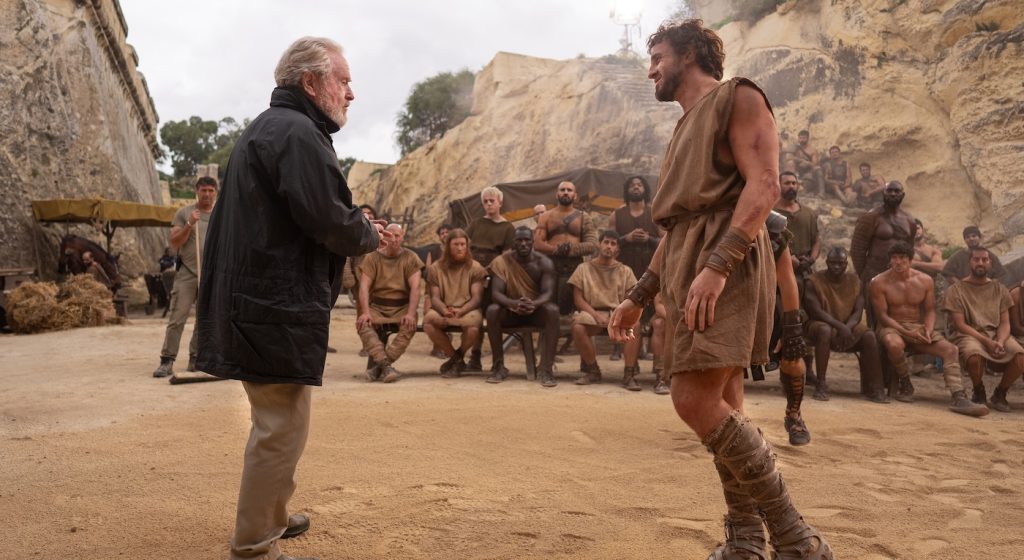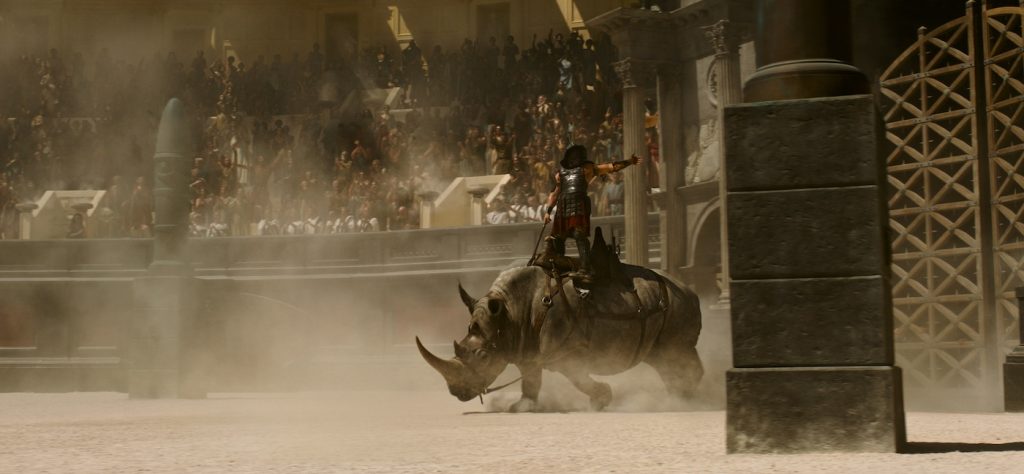Maximus Effort: “Gladiator II” Production Designer Arthur Max on Creating Colossal Constructions
Oscar-nominated production designer Arthur Max has worked on 16 of Ridley Scott’s films. These include some of American cinema’s most indelible cinematic spectacles, such as the original Gladiator (for which Max scored his first Oscar nod), Black Hawk Down, and The Martian. Despite the impressive body of work between them, Max thinks that the Roman epic actioner, Gladiator II, is their most ambitious yet. For instance, his crew built not one—but two—replicas of the Colosseum, where the numerous gladiatorial battles were staged.

Sharp-eyed viewers may experience déjà vu. In the opening sequence, Pedro Pascal’s General Acacius leads the Roman navy in a savage invasion of Lucius’ (Paul Mescal) adopted hometown of Numidia. The naval battle and ensuing siege were filmed in Morocco after Max’s team repurposed the set from Kingdom of Heaven, another film he had worked on with Scott almost two decades ago. “It was in the spirit of recycling in the best possible way. It survived very well, which is a testament to how it was built and maintained,” says Max.
Taking place 15 years after Russell Crowe’s Maximus died in the original film, combat in the Colosseum is now even more sadistic and cruel. After the Roman navy defeats the Numidians—killing many villagers, including Lucius’ wife in the process—he and his fellow slaves are brought to Rome. There, Machiavellian businessman Macrinus (Denzel Washington) adds him to his stable of gladiators, who are forced to fight to the death against some ghastly beasts— a rhinoceros, tigers, and baboons—merely to entertain the royal court and the masses.
More than two decades after Gladiator won Best Picture in 2001, Max reflects on how much technology has changed. “Since we didn’t have the same technology on the first film, prep, building, and shooting took much longer even though the scale was proportionally smaller [on Gladiator], and we shot both in the same locations. This time, we made a bigger movie in a shorter period of time, thanks to the evolution of technology,” he reveals.
What are some of the major differences in your work when comparing the two films?
On the first one, we didn’t have all the tools to truly celebrate the glory of ancient Rome. But now, technology allows us to amplify the physical set and the architecture. It’s much quicker and you can go bigger. The scale was big on Gladiator, but it wasn’t as big compared to the ruins of ancient Rome. We were really struck by the immensity of their architecture. So, I tried to do it justice in this movie.
Lucius’ hometown, Numidia, was filmed in the desert of Morocco on the former set of Kingdom of Heaven. What was it like to revisit that set after almost twenty years?
It was in the spirit of recycling in the best possible way, but it wasn’t big enough. The front wall on Kingdom of Heaven was 500 feet long. We wanted to celebrate the scale of the Roman Empire and Lucius’ world. So, we added a couple hundred feet to the length and width and created a port as well since we had ships in this naval attack. It seems anomalous to have Roman warships in the desert, but our visual effects director thought it was easier to put the water in digitally rather than filming on water.

There was actually no water in that naval invasion sequence?
We had a small tank for close-ups in the water. But that was minor compared to the size of the wall, and it was only used for close-ups where the actors were physically in the water and then extended digitally. The post software for water now is very sophisticated. It’s much easier to work in the dry when you’re doing elaborate camera work, stunt work, and explosions with 12 cameras and trying to meet a schedule. We did the water work in Malta in a beautiful tank facility. But in Morocco, we had blue screens attached to hydraulic vehicles, which creates a big cyclorama wherever you need it.

What about the ships? How did you get those into the middle of the desert?
We built two full-sized Roman warships: the ramming ship and the siege tower ship for the attack. To build General Acacius’ fleet, we redressed those several times with different sails, paintwork, and flags to get a fleet of hundreds of ships with great variety. How did we move them around with no water would be your question, right? Our special effects supervisor, Neil Corbould, found a really brilliant solution with a remote-controlled hydraulic all-wheel drive that was electric battery operated. It was like an enormous e-vehicle that moved industrial objects, and we built our ships on those. The ships could pitch, yaw, and roll just like a real one on water. But it was a lot more practical to load the crew and equipment, dress it, do stunt work, and manipulate in the dry. Technology came to our rescue.
For the gladiatorial battles, you returned to Fort Ricasoli in Malta, where you built one of the two replicas of the Colosseum at 60% scale.
In Gladiator, I think we only used two-thirds of the fort due to time and money. But this time, we used the whole fort. It’s an archeological historical site, so we had to get government permission to work there. It was quite difficult, and we took a lot of care in handling the rubble. In fact, they found some new ruins that they didn’t know were there, so they were quite happy about that.


It’s extraordinary that you were filming and working at an archeological site!
The fort dates back to the 18th century and has been used as a fortress. We were allowed to work within certain limits to clear away some of the rubble. They were nervous about it, understandably. We were very careful about it; we had engineers and supervisors from the archeological department monitoring everything. So that’s why we could build larger sets this time. Some of it had to be done by hand, like an archeological dig, and we discovered cisterns under the arena that we didn’t know about the first time. On Gladiator, there were some temporary modern walls in the interiors going up to the roofs of the fort. I got an old plan from the building department and noticed there were spaces behind the wall, so I asked the government if we could dismantle the wall, which was very modern; it wasn’t an old original wall. We were curious about what was behind it, and perhaps we could see it in the film, which we did.

Were you near where you built the Colosseum replica for the original Gladiator?
Absolutely the same footprint. John Mathieson, our DP, was very keen to be exactly where it was because of the light—the sunlight doesn’t change over 25 years. So, he wanted the sun to move around the set exactly as before. The only thing was, the existing walls of buildings constrained the size, so we weren’t able to build the whole thing. We extended it digitally with blue screens and plates. With technology advancements, it was much easier and quicker this time around.
Check out part two of our conversation with Arthur Max about creating the mock naval battle in the Colosseum and more.
For more on Gladiator II, check out these stories:
“Gladiator II” Screenwriter David Scarpa on the Herculean Task of Writing a Worthy Sequel
“Gladiator II” Enters International Arena With a Powerful Opening Weekend
Featured image: Gladiator II from Paramount Pictures.



